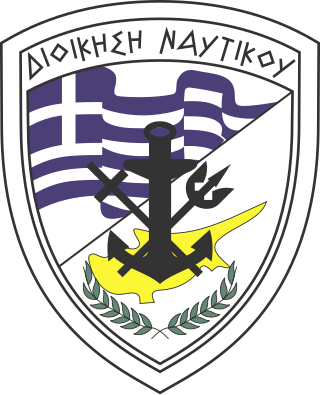Transport in Cyprus consists of transport by land, water and air. Road transport is the primary mode of transport for most Cypriot citizens, and Cyprus's road transport systems are well-developed and extensively used across the island.

Nicosia is the capital and largest city of Cyprus. It is the southeasternmost of all EU member states' capital cities.

The Ethniki Organosis Kyprion Agoniston was a Greek Cypriot nationalist guerrilla organization that fought a campaign for the end of British rule in Cyprus, and for eventual union with Greece.

Georgios Grivas, also known by his nickname Digenis, was the Cypriot founder and leader of the Greek and Greek Cypriot paramilitary organisations Organization X (1942–1949), EOKA (1955–1959) and EOKA B (1971–1974).

Larnaca District is one of the six districts of Cyprus. Its capital is Larnaca. It is bordered on the east by Famagusta District, on the north by Nicosia District and on the west by Limassol District.
Nikos Sampson was a Cypriot journalist, militant and politician, who was installed as acting President of Cyprus during the 1974 coup.
Grigoris Pieris Afxentiou was a Greek-Cypriot insurgent leader who led campaigns against the British colonial government as a member of EOKA. He was second-in-command to general Georgios Grivas and used the pseudonym Zidhros (Ζήδρος), the name of a famous 18th-century brigand.

Liopetri is a village in southern Famagusta District, in Cyprus. It is close to the communities of Frenaros, Sotira, Avgorou and Xylofagou. In 2011, Liopetri had a population of 4,591.

Armenian Cypriots are the ethnic Armenian population native to Cyprus. The Armenian Cypriot community has had a significant impact upon the Armenian people as a whole despite its low numbers. During the Middle Ages, Cyprus had an extensive connection with the Armenian Kingdom of Cilicia, while the Ganchvor monastery had an important presence in Famagusta. During the Ottoman Era, the Virgin Mary church and the Magaravank were very prominent. Certain Armenian Cypriots were or are very prominent on a Panarmenian or international level and the survivors of the Armenian genocide have co-operated and co-existed peacefully with the Turkish Cypriots.

Several distinct periods of Cypriot intercommunal violence involving the two main ethnic communities, Greek Cypriots and Turkish Cypriots, marked mid-20th century Cyprus. These included the Cyprus Emergency of 1955–59 during British rule, the post-independence Cyprus crisis of 1963–64, and the Cyprus crisis of 1967. Hostilities culminated in the 1974 de facto division of the island along the Green Line following the Turkish invasion of Cyprus. The region has been relatively peaceful since then, but the Cyprus dispute has continued, with various attempts to solve it diplomatically having been generally unsuccessful.

The Cyprus Police, is the national police service of the Republic of Cyprus, falling under the Ministry of Justice and Public Order since 1993.

The Cyprus Emergency was a conflict fought in British Cyprus between April 1955 and March 1959.
This page list topics related to Cyprus.

The Cyprus Naval Command is the armed sea wing of the Cyprus National Guard. The Cypriot Navy has the primary mission of defending the maritime borders of the Republic of Cyprus, but is currently unable to access the waters around Northern Cyprus, which have been controlled by the Turkish Navy since the 1974 Turkish invasion of Cyprus. This force does not possess any capital ships or other major warships, but is equipped with patrol boats, landing craft, surface-to-surface missile systems and integrated radar systems, as well as SEALs-type naval underwater demolitions units.

The Cyprus Port & Marine Police is the marine police and the civilian Coast Guard wing of the Cyprus Police. The coast guard are tasked with the primary mission of law enforcement of the waters around, and control of the sea borders of the Republic of Cyprus. Main roles are reported to include law enforcement of illicit activities such as smuggling, terrorism, piracy and illegal fishing. The Cyprus Port and Marine Police also serve a role as a search and rescue (SAR) force. This force is equipped with patrol boats and radars.
The Police Station Attacks were a series of guerrilla style attacks by the EOKA on police stations in Cyprus during June 1955 which led to the start of the Cyprus Emergency. The attacks took place:
The Battle of Yialousa was a minor engagement on 17 December 1955. As part of the Cyprus Emergency, armed men of the EOKA took part in a series of attacks on police stations across Cyprus. The police station at Yialousa was attacked by 12 men resulting in the death of a British artillery officer, Lieutenant John Kelly.
Armenians have a long history in Cyprus, with the first confirmed presence of Armenians on the island dating back to 578 AD, during the reign of Byzantine Emperor Justin II. In the modern Republic of Cyprus, they are recognized as one of the three minority "religious groups" along with the Maronites and Latins.
The 1956–57 Cypriot Second Division was the fourth season of the Cypriot second-level football league. Apollon Limassol won their 1st title.

Legislative elections were held in Cyprus on 6, 7 and 8 June 1883. They were the first elections to the newly established Legislative Council.











